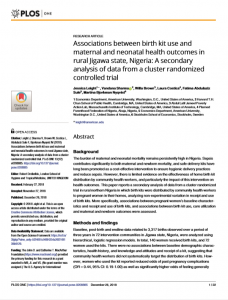
Abstract
Background
The burden of maternal and neonatal mortality remains persistently high in Nigeria. Sepsis contributes significantly to both maternal and newborn mortality, and safe delivery kits have long been promoted as a cost-effective intervention to ensure hygienic delivery practices and reduce sepsis. However, there is limited evidence on the effectiveness of home birth kit distribution by community health workers, and particularly the impact of this intervention on health outcomes. This paper reports a secondary analysis of data from a cluster randomized trial in rural northern Nigeria in which birth kits were distributed by community health workers to pregnant women in their homes, analyzing non-experimental variation in receipt and use of birth kits. More specifically, associations between pregnant women’s baseline characteristics and receipt and use of birth kits, and associations between birth kit use, care utilization and maternal and newborn outcomes were assessed.
Methods and findings
Baseline, post-birth and endline data related to 3,317 births observed over a period of three years in 72 intervention communities in Jigawa state, Nigeria, were analyzed using hierarchical, logistic regression models. In total, 140 women received birth kits, and 72 women used the kits. There were no associations between baseline demographic characteristics, health history, and knowledge and attitudes and receipt of a kit, suggesting that community health workers did not systematically target the distribution of birth kits. However, women who used the kit reported reduced odds of past pregnancy complications (OR = 0.44, 95% CI: 0.19-1.00) as well as significantly higher odds of feeling generally healthy at baseline (OR = 2.00, 95% CI: 1.06-3.76), of exposure to radio media (OR = 1.97, 95% CI: 1.21-3.22), and of perceiving themselves as having a low-risk pregnancy (OR = 3.05, 95% CI:1.39-6.68). While there were no significant associations between birth kit use and facility based delivery, skilled birth attendance or post-natal care, women who used a kit exhibited significantly lower odds of completing four or more ANC visits (adjusted OR = 0.39, 95% CI: 0.18-0.85) and significantly higher odds of reporting prolonged labor (adjusted OR = 4.75, 95% CI: 1.36-16.59), and post-partum bleeding (adjusted OR = 3.25, 95% CI: 1.11-9.52).
Conclusions
This evidence suggests that use of birth kits is low in a rural population characterized by minimal baseline utilization of maternal and neonatal health services, and the use of birth kits was not associated with reductions in maternal or neonatal morbidity. While further research is required to understand how the effectiveness of birth kits may be shaped by the mechanism through which women access and utilize the kits, our findings suggest that the provision of kits to women outside of the formal health system may be associated with increased risk of adverse outcomes.
Access the original article and any supplementary material here.